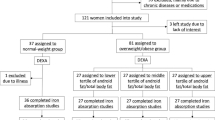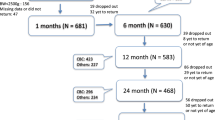Abstract
Iron deficiency has been linked to obesity. Hepcidin is the main regulator of iron homeostasis and is higher in obese children compared to controls. To gain insight into the link between obesity and hepcidin, we performed an intervention study in 15 obese children. These children were subjected to a 6-month weight loss program and underwent physical examination and iron status and absorption as well as hepcidin, interleukin-6 and leptin serum levels evaluation at baseline and after the weight loss program. After the program all children reduced their body mass index standard deviation score (BMI SDS) of at least 0.5. We observed a significant decrease in hepcidin (P=0.003) and leptin levels (P=0.005), and a significant increase in iron absorption (P=0.02). A direct correlation between the measure of hepcidin and leptin reduction was observed and this correlation appeared significant (r2=0.33, P=0.003) when adjusted for interleukin-6 and BMI SDS variations. In conclusion, we have shown that, in obese children, BMI reduction is associated with hepcidin reduction, potentially improving iron status and absorption. Implications of these findings could be considered in the management of obese children with poor iron status.
This is a preview of subscription content, access via your institution
Access options
Subscribe to this journal
Receive 12 print issues and online access
$259.00 per year
only $21.58 per issue
Buy this article
- Purchase on Springer Link
- Instant access to full article PDF
Prices may be subject to local taxes which are calculated during checkout

Similar content being viewed by others
References
Harris RJ . Nutrition in the 21st century: what is going wrong. Arch Dis Child 2004; 89: 154–158.
Nead KG, Halterman JS, Kaczorowski JM, Auinger P, Weitzman M . Overweight children and adolescents: a risk group for iron deficiency. Pediatrics 2004; 114: 104–108.
Andrews NC . Forging a field: the golden age of iron biology. Blood 2008; 112: 219–230.
Verga Falzacappa MV, Vujic Spasic M, Kessler R, Stolte J, Hentze MW, Muckenthaler MU . STAT3 mediates hepatic hepcidin expression and its inflammatory stimulation. Blood 2007; 109: 353–358.
Chung B, Matak P, McKie AT, Sharp P . Leptin increases the expression of the iron regulatory hormone hepcidin in HuH7 human hepatoma cells. J Nutr 2007; 137: 2366–2370.
Aeberli I, Hurrell RF, Zimmermann MB . Overweight children have higher circulating hepcidin concentrations and lower iron status but have dietary iron intakes and bioavailability comparable with normal weight children. Int J Obes 2009; 33: 1111–1117.
Tussing-Humphreys LM, Nemeth E, Fantuzzi G, Freels S, Guzman G, Holterman AX et al. Elevated systemic hepcidin and iron depletion in obese premenopausal females. Obesity 2010; 18: 1449 .
Miraglia del Giudice E, Santoro N, Amato A, Brienza C, CalabrÒ P, Wiegerinck ET et al. Hepcidin in obese children as a potential mediator of the association between obesity and iron deficiency. J Clin Endocrinol Metab 2009; 94: 5102–5107.
Cacciari E, Milani S, Balsamo A, Spada E, Bona G, Cavallo L et al. Italian cross-sectional growth charts for height, weight and BMI (2 to 20 yr). J Endocrinol Invest 2006; 29: 581–593.
Cole TJ . The LMS method for constructing normalized growth standards. Eur J Clin Nutr 1990; 44: 45–60.
Castaldo A, Tarallo L, Palomba E, Albano F, Russo S, Zuin G et al. Iron deficiency and intestinal malabsorption in HIV disease. J Pediatr Gastroenterol Nutr 1996; 22: 359–363.
De Morais MB, Suzuki HU, Corral JN, Machado NL, Neto UF . Asymptomatic giardiasis does not affect iron absorption in children with iron deficiency anemia. J Am Coll Nutr 1996; 15: 434–438.
Swinkels DW, Girelli D, Laarakkers C, Kroot J, Campostrini N, Kemna EH et al. Advances in quantitative hepcidin measurements by time-of-flight mass spectrometry. PLoS ONE 2008; 3: e2706.
Santoro N, Perrone L, Cirillo G, Raimondo P, Amato A, Brienza C et al. Effect of the melanocortin-3 receptor C17A and G241A variants on weight loss in childhood obesity. Am J Clin Nutr 2007; 85: 950–953.
Tussing-Humphreys LM, Nemeth E, Fantuzzi G, Freels S, Holterman AX, Galvani C Ayloo S et al. Decreased serum hepcidin and improved functional iron status 6 months after restrictive bariatric surgery. Obesity 2010 e-pub ahead of print 14 January 2010; doi:10.1038/oby.2009.490.
Morris DL, Rui L . Recent advances in understanding leptin signaling and leptin resistance. Am J Physiol Endocrinol Metab 2009; 297: E1247–E1259.
Adam CL, Findlay PA . Decreased blood–brain leptin transfer in an ovine model of obesity and weight loss: resolving the cause of leptin resistance. Int J Obes 2010; 34: 980–988.
Acknowledgements
This work was supported by grant from Ministero dell’Università, PRIN 06/08 (to LP and EMDG).
Author information
Authors and Affiliations
Corresponding author
Ethics declarations
Competing interests
The authors have nothing to disclose with the exception of DWS who is a co-founder and medical director of the ‘Hepcidinanalysis.com’, an initiative that aims to serve the scientific and medical community with high-quality hepcidin-25 measurements.
Rights and permissions
About this article
Cite this article
Amato, A., Santoro, N., Calabrò, P. et al. Effect of body mass index reduction on serum hepcidin levels and iron status in obese children. Int J Obes 34, 1772–1774 (2010). https://doi.org/10.1038/ijo.2010.204
Received:
Revised:
Accepted:
Published:
Issue Date:
DOI: https://doi.org/10.1038/ijo.2010.204
Keywords
This article is cited by
-
Chronic intermittent hypobaric hypoxia improves markers of iron metabolism in a model of dietary-induced obesity
Journal of Inflammation (2020)
-
Are overweight and obesity in children risk factors for anemia in early childhood? Results from a national nutrition survey in Tajikistan
International Journal of Public Health (2018)
-
Hepatic iron storage is related to body adiposity and hepatic inflammation
Nutrition & Metabolism (2017)
-
Physical exercise intervention at school improved hepcidin, inflammation, and iron metabolism in overweight and obese children and adolescents
Pediatric Research (2017)
-
Serum Hepcidin and Soluble Transferrin Receptor in the Assessment of Iron Metabolism in Children on a Vegetarian Diet
Biological Trace Element Research (2017)



